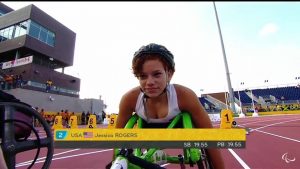
The Olympics, the Paralympics and Special Olympics are all sports organizations. The Olympics gathers the top athletes from each country for competition. The Paralympics does the same. The Special Olympics and the Paralympics are both sports organizations for disabled athletes but they are very different organizations and are not connected. Many people confuse the Paralympics and the Special Olympics. The two organizations are different in at least three key areas:
- The disability categories of athletes that compete in the programs are different.
- The training, criteria and philosophy under which the athletes compete are different.
- The structures of the individual organizations are different.
Because there is so much confusion between the Special Olympics and the Paralympics, some clarification is needed.
First of all, the athletes in each organization are very different. In the Special Olympics, the athletes must have cognitive delays (intellectual or developmental disabilities). The age minimum is eight years old, and a majority of athletes involved with Special Olympics are children, although adults do participate too. There are age divisions. In contrast, athletes involved in Paralympic sports are mainly those with physical disabilities as opposed to intellectual ones. However, there are also two categories for blind swimmers and one for swimmers with intellectual disabilities. Although there is no age limit or minimum for the Paralympic games, as long as the athlete is at a reasonable age to compete, most Paralympians are young adults between 18 and 30 because the level of competition is elite. Development in the technique and power of the sport requires many years of training. There are age divisions at a junior level, but once a junior age athlete moves into actual Paralympic competition events, there are no age divisions.
Training is also different. While there are some exceptions, generally an athlete going to a Special Olympic competition may spend one season learning to swim and practicing swimming once or twice a week and then go to a swim meet. The next season, they may practice volleyball, and then compete in Special Olympics volleyball games. An athlete training for the Paralympics, on the other hand, has essentially the same training regimen as an Olympic athlete, with year round, intense daily and highly specialized training in a specific sport. Some Paralympic athletes train along with Olympic athletes at the Olympic training facilities in their countries.
In addition, the criteria and philosophy under which athletes participate differ widely in the two organizations. The Special Olympics believes in using athletics as an avenue to reach an individual person’s maximum potential. No one is excluded or left out based on their skill. All athletes are welcomed and rewarded for working hard, trying their best and maximizing their potential. Selection for higher level competition, such as advancing from state to national level, may occur through a lottery type system. In Paralympic activities, athletes with disabilities are welcomed to train, and the benefit to physical health is noted, but the emphasis is on elite level competition. Only those few athletes who meet qualifying standards compete at national and international levels. Qualifying standards at set for each event and become harder and harder at each level of competition. Each sport in the Paralympic Games has its own criteria and standards, so in order to compete you must be one of the best based on your performance. Only the top athletes in the world in each category are chosen to represent their individual countries in the Paralympic Games. Similar to the Olympic athlete, fractions of a second, or a centimeter of distance may separate the winners. Similar to the Olympic athlete, there is monetary compensation for achieving gold, silver, or bronze medal wins at the Paralympic Games.
Finally, the structures of the respective organizations differ greatly. The Special Olympics is a worldwide organization for athletes with intellectual disabilities with a goal of spreading awareness of inclusion, acceptance, and dignity for all its participants. Programs exist throughout 170 countries and over 220 programs are operating daily. It is governed by an International Governing Board of Directors. There is no affiliation with the Olympics or the Olympic Games. The Paralympics however, is run by the International Paralympic Committee (IPC). The IPC and the IOC, which governs the Olympics, have joined together. The country which is selected to host the Olympic Games must also host the Paralympic Games the following week. The IPC committee members are chosen from around the world to best represent international disabled athletes. The highest level of governance in the program is The General Assembly and includes members from 165 nations. Each country participating in the Paralympics has a National Governing Organization (NGO) and holds a roster of licensed Paralympic athletes. The policies and rules for these athletes are similar to those for Olympic athletes, such as mandatory random drug testing.
